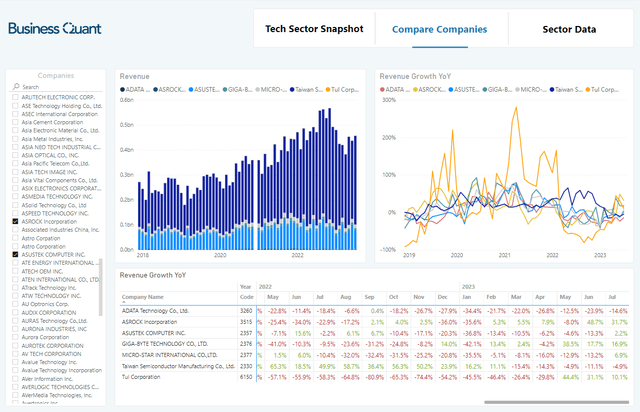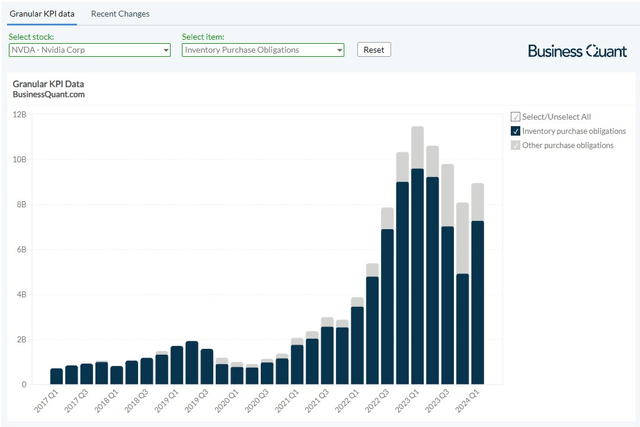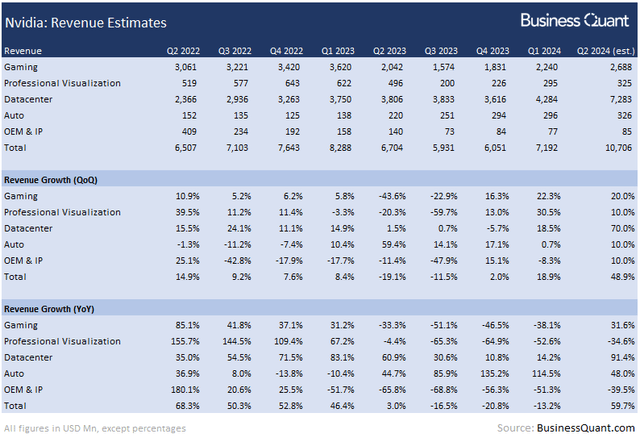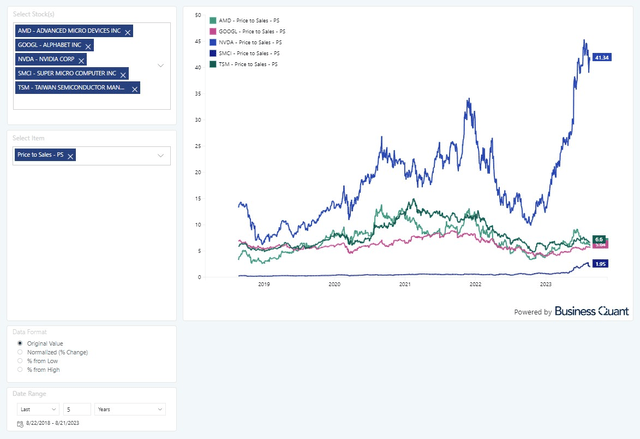Summary:
- Nvidia is scheduled to report Q2 results after market close this Wednesday.
- Pay close attention to its purchase obligations, segment revenue and its management’s guidance.
- The stock seems ripe for a significant pullback from its current levels.
kynny
After the bell next Wednesday, we’ll receive Q2 FY24 results from Nvidia (NASDAQ:NVDA). The chipmaker has been one of the very few names in the semiconductor space that has reported burgeoning sales amidst the global macroeconomic slowdown, so, investors will be keenly watching how its revenue fares in Q2. But in addition to tracking its headline sales figure, investors may also want to monitor its purchase obligations, segment revenue and management’s outlook for the quarter ahead. At the outset, it seems that Nvidia is a “Sell” heading into its earnings.
The Premise for Slowdown
There’s no denying that Nvidia has done well for itself in spite of a global macroeconomic slowdown in recent quarters, but I contend that its streak of outperformance is likely to fizzle out soon.
Enterprises across the globe amped up their AI-related capex in Q1 and invested heavily into datacenter GPUs once they understood the prospects of generative AI. Nvidia turned out to be the prime beneficiary amidst this buying spree as there wasn’t any significant competition out there. Although AMD (AMD) also manufactures consumer and datacenter GPUs, its SKUs lacked out-of-the-box software support for AI/ML workflows. This meant that anyone looking to deploy large-language models or other ML/AI variations were largely limited to Nvidia cards.
But two things seem to be happening simultaneously. First, the enterprise demand for GPUs seems to be waning, and we’re likely to see the full-fledged effect of this slowdown within the next 2 quarters. Super Micro (SMCI), which uses Nvidia GPUs in its AI platforms, noted in its latest earnings call that they’re supply constrained and as a result, will be revenue challenged in the near future. Super Micro’s stock has tanked 31% since this statement. Taiwan Semiconductor (TSM), which manufactures chips for Nvidia and AMD, also lowered its revenue guidance and its shares fell as a result.
The fact that Nvidia’s channel partners are slashing their guidance, suggests the demand for AI platforms and/or GPU chips in general has slowed down of late. The snapshot below highlights another interesting picture. Our database at Business Quant reveals that monthly revenue growth for many of Nvidia’s channel partners has remained lackluster in June and July. So, I believe Nvidia may also experience this slowdown in a quarter or two, once its channel inventories drop and older stock of prior generation SKUs depletes for good.
Secondly, AMD and other major tech enterprises have stepped up their game. For starters, AMD’s MI300 datacenter SKUs will become commercially available this year. It’s the world’s first datacenter APU (which is a CPU and a GPU in one package) and will compete directly against Nvidia’s H100. The chipmaker also improved software support for AI/ML applications. Super Micro’s management noted in their earnings call that their sell-throughs for AMD-branded datacenter GPUs are now improving. This suggests that market-wide adoption for AMD cards is growing, and it might continue to grow once MI300 cards are out.
We are also getting good traction on Intel’s Gaudi 2 and PVC, as well as AMD’s MI-250 accelerator solutions.
Besides this, Google (GOOG) (GOOGL) announced last quarter that it has developed its own datacenter GPU that outperforms Nvidia’s A100 whilst consuming less power. Samsung and Hyundai are backing an AI startup called Tenstorrent to rival Nvidia. Basically, the point that I’m trying to make here is that competition is starting to intensify in the GPU space which is bound to put pressure on Nvidia’s pricing power and on its market share in the quarters ahead. So, I contend that Nvidia’s AI-backed rally is nearing its end and its growth trajectory will simmer down in the near future.
Items to Monitor in Q2
There are broadly 3 items that we’d need to monitor in Nvidia’s upcoming earnings report, to corroborate our thesis. For starters, if the chipmaker is actually experiencing a slowdown in enterprise demand, then it won’t place as many orders with its fabrication, assembly, and distribution partners. I personally believe that this scenario will play out, and it will result in a sequential as well as a year-over-year decline in Nvidia’s purchase obligations. On the other hand, if it’s business as usual for Nvidia, and its outlook is equally encouraging then its purchase obligations will remain elevated.
Secondly, look at Nvidia’s segment revenue. The chipmaker classifies its revenue in 5 verticals, namely Gaming, Datacenter, Professional Visualization, Automotive and OEM/IP. Out of these, the datacenter division accounted for nearly 60% of the company’s total revenue last quarter. Given how well the chipmaker has sold its cards in the enterprise channel last quarter, I expect this revenue stream to grow 70% sequentially and amount to $7.2 billion in Q2. The rationale for this staggering growth estimate is Nvidia management’s guidance in the prior earnings call, where they noted that the bulk of their revenue growth will come from this particular business division.
Secondly, Nvidia’s gaming division accounted for a little over 31% of the company’s total sales last quarter. As more budget GPUs have become commercially available in the last quarter, I estimate that mainstream adoption of RTX40-series GPUs will grow, and the gaming segment will register a 25% sequential revenue growth during Q2, with revenue amounting to $2.7 billion.
Nvidia’s other 3 business divisions, namely Professional Visualization, Auto, and OEM/IP are immaterial for the company’s top line as they collectively contributed just 9% to the company’s total sales last quarter. So, I have a generic estimate of 10% sequential revenue growth for these divisions. This brings us to a company-wide revenue estimate of $10.7 billion for Q2. Bear in mind that my estimate is slightly lower than the Street’s consensus that’s spanning from $10.96 billion to $11.17 billion for Q2, as of this writing.
Lastly, pay close attention to Nvidia management’s revenue outlook for Q3 and for FY24 in general. Any hint of a slowdown can induce panic selling on the Street and send the chipmaker’s shares crashing. At the same time, if the management is able to issue an upbeat guidance, then it’ll inspire confidence amongst investors and encourage them to accumulate the chipmaker’s shares in my view.
Final Thoughts
There’s no denying that Nvidia is doing incredibly well for itself and its shareholders. The company has a trillion-dollar market cap, and it continues to innovate even still.
At the same time, I believe the stock has become a little detached from ground reality. To put things in perspective, Nvidia’s shares are trading at over 41 times the company’s trailing twelve-month sales. This Price-to-Sales multiple is hovering at a 5-year high for Nvidia, and it’s also much higher than many of the chipmaker’s prominent peers.
This suggests that Nvidia’s shares are priced for perfection and even a hint of a slowdown can induce panic selling in the name. With channel partners showing signs of a slowdown and competition intensifying, I believe this is a good time for Nvidia investors to sell or trim their holdings while its shares are still at elevated levels. Good Luck!
Analyst’s Disclosure: I/we have no stock, option or similar derivative position in any of the companies mentioned, and no plans to initiate any such positions within the next 72 hours. I wrote this article myself, and it expresses my own opinions. I am not receiving compensation for it (other than from Seeking Alpha). I have no business relationship with any company whose stock is mentioned in this article.
Seeking Alpha’s Disclosure: Past performance is no guarantee of future results. No recommendation or advice is being given as to whether any investment is suitable for a particular investor. Any views or opinions expressed above may not reflect those of Seeking Alpha as a whole. Seeking Alpha is not a licensed securities dealer, broker or US investment adviser or investment bank. Our analysts are third party authors that include both professional investors and individual investors who may not be licensed or certified by any institute or regulatory body.




